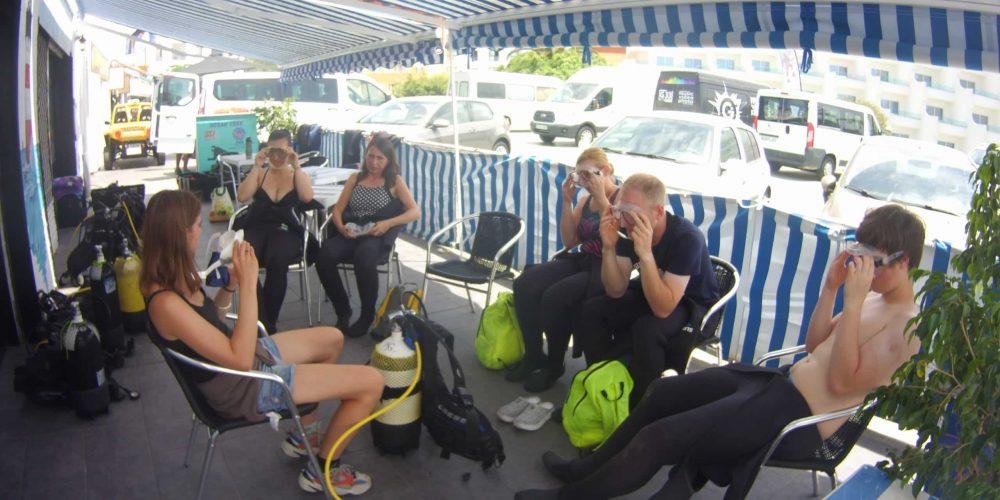As with other things in life, starting is the hardest and most exciting aspect of diving. You might ask yourself how dangerous a try dive really is, if you meet the physical requirements, how to find a good diving school, or whether you will dare to start at all.
I shall begin this post with the supposed “danger” of scuba diving by assuring you that diving is statistically one of the safest sports one can practice, and actually poses, as long as you follow the rules, little or no danger. And which rules would those be? Some pretty basic ones indeed: no diving alone, no diving too deep nor for too long, no diving without the required experience in unfamiliar sites….
Physically, scuba diving is neither difficult nor strenuous, a try dive is far less demanding and requires far less energy or stamina than other popular sports such as running, spinning, or tennis playing. The most exhausting aspect of scuba diving is to don your diving equipment and get into the water. Once in the water you will become weightless and shall never get out of breath. That is why divers underwater always move slowly, just like astronauts in the outer space.
You do not have to be a good swimmer either. Even non-swimmers can do a try dive when assisted by a bona-fide qualified instructor.
By far, the most common problem and biggest obstacle beginners may have to negotiate the first time they dive is their fear to be unable to breathe underwater…. You ought to convince yourself that you can do it and thus overcome your concerns. For children this is often a much shorter process than it may be for adults. After a few exercises in shallow water, your brain will accept the new status quo and the uncertainty will quickly give way to the great feeling of floating silently and effortlessly underwater.
Having dissipated your doubts, how do you find the right diving school now? In principle you can assume that diving schools which belong to one of the big diving organisations such as PADI, SSI or CMAS will follow the international standards for safe diving, since failure to adhere to such standards results in loss of licence.
Having said that, TRY DIVE programs may vary greatly from one dive centre to another and from one instructor to another: You can do the course in smaller or larger groups, dive from the shore or from a boat. You can be pulled around through shallow water or a swimming pool for just a few minutes by an instructor holding you from your tank valve, or you can go through a proper mini diving course with theoretical introduction, practice of the most important diving skills in shallow water, followed by a ‘real’ dive of 45-60 minutes to a depth of maximum 12 meters; the possibilities are countless, but if the price and the instructor are right, everyone can have a lot of fun.
First of all it should be said that it is much easier to dive for the first from land: diving from shore (instead than from a boat) allows you to slowly get used to the new environment while in shallow water and progressively go deeper within the shelter of a protected bay. Boats are often small and shaky, the water is usually deeper, and, in order to dive, you will have to go down steeply along the anchor line, something that can be too fast and/or abrupt for many beginners.
The first time it is mainly a psychological matter: If you encounter a relaxed atmosphere in the dive centre of your choice, if members of staff take enough time to lead you through the diving experience, you will find that it will be a very easy and stress-free experience for you. On the other hand, a dive centre that offers, for example, 5 different ‘Try Dive’ programs per day, will probably have a very tight schedule and will abort a dive at the first, smallest difficulty. It is very important that both you and the dive center of your choice allocate enough time to carry out the activity in order to guarantee this can be realized successfully and be thoroughly enjoyed without the added worry of having planned another activity shortly after.
It is always advisable to book directly with a diving school and not through any agency or other intermediary: This way you can get an idea of what the diving centre looks and feels like, have an initial contact with its members of staff, and plan together your TRY DIVE course for your maximum enjoyment.
Another very important reason for not booking your diving trip through a tour operator or a ticket dealer is that, most likely, they will offer you not the best and most reliable diving school but the diving center that pays them the highest commission. Since quite often these commissions can represent up to two thirds of the actual selling price, the diving center in question must make up for it the loss of income by organising larger groups, and/or by offering poorer service and less up-to-date equipment.
TRY DIVE with Ocean Trek:
- We usually dive twice a day, except on Sundays, at 9:30 and 13:30 in small groups, so that your personal instructor is always by your side.
- We offer a proper mini-diving course that, If you wish, can be used as a credit toward a Scuba– or Open Water Diver certification.
- The course usually takes about 3-4 hours and it includes a theoretical introduction, a practical session in shallow water with some easy and basic skills, and a dive of about 45 minutes to a maximum depth of 12 meters.
- On the day of your Try Dive, we will first of all give you a diving suit that fits you, usually 5-7mm neoprene in winter or a 3mm shorty between July and September. However, you can choose the option you feel more comfortable with.
- Afterwards we will do the briefing, explain you how the equipment works, the easy skills we will practice in shallow water, the basic rules and underwater signs, and finally plan the course of the dive.
- We have 3 different dive sites which are especially suitable for a trial dive. Depending on the weather conditions, we will reach the dive site after a short drive of 10-20 minutes by minibus or jeep.
- During your dive you will observe the interesting volcanic underwater world of Tenerife, see plenty of fish, and, with a little luck, also turtles or rays.
- Upon request, we can shoot a digital video or take digital photographs (both on land and underwater) of your entire diving day. Videos and photograph’s may be watched/looked at prior to purchase once back at the dive center.
Please do not hesitate to contact us should you have doubts or questions, or book a course directly online!




